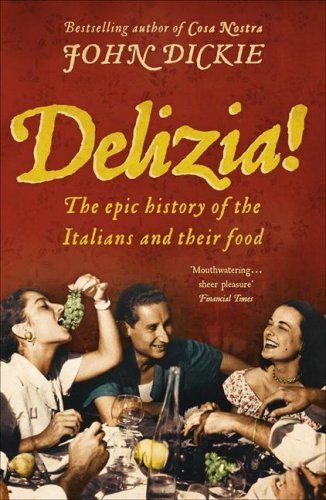Delizia! by John Dickie Published: 2008 Read from: 01 Sep to 04 Oct My rating: 🌟 🌟 🌟 🌟 🌟
You might think, what with my interest in food and living in Italy, that I would have devoured this book when it first came out, but I didn’t, and I don’t know why. It is so glorious, in so many respects. Most importantly, it gives the lie to the idea that Italian food is a food of poverty or somehow an essentially rustic food. From the start, with a consideration of the influences on food in Palermo — not Sicily — in the 12th century, to his thoughtful dismemberment of some of Slow Food’s excesses — Dickie is at pains to place the development of Italy’s food in its cities, not the countryside.
The cities, as Dickie shows over and over, had the wealth and the power to extract all that was good from their own countryside and from further afield. That is why there are so many dishes named for the cities in which they were developed and why, even after unification, there still isn’t much of a sense of national cuisine.
In fact, while the “ancient” history of food in Italy is undoubtedly interesting and informative I found the more modern sections even more interesting as they dissect current incarnations of Italian food.
Cities are where Italian food happens, as Dickie says, even when that food is an interpretation of, say, a dish like ribollita, which differed from household to household and didn’t begin to be codified as such until the 1960s. Dickie uses the story of Tuscan stale bread soup to trace so many of the different strands that went into the creation of Italian food, from the demands made by the mezzadria system of sharecropping, especially on the women of the household, to Artusi’s efforts to create a national cuisine, to the mass exodus from the land in the 1950s and 1960s. Ribollita, however, is by no means the only dish that shares this kind of history, and examples abound throughout the book.
The whole notion of the authentic recipe for a dish is, as Dickie shows in detail, a very modern fetish. Pesto sauce, for example, he examines with care through the hugely touching cookbooks compiled from memory by First World War prisoners. Italy has more foods protected by an officially recognised designation than any other country in Europe, including pesto that may or may not contain the officially sanctioned basilico Genovese DOP. While certification undoubtedly added to the value of those foods, the very codification of ingredients and methods has also prevented the innovation that originally created some of those dishes, including pesto.
There are plenty of other insights. In the fascist era, for example, the cost of food ate up way more than a third of the average family income. Mussolini’s famous Battle for Grain, which I’ve always seen presented as a fight for self-suffiency, Dickie says was as much about wooing the rich landowners of the Po Valley with a larger market, and higher prices, for their produce.
The miracle of Italy’s post-war development can be seen in how much polenta the people ate. Bearing in mind that it was far more a dish of the north than the south, in the 1950s average consumption across the entire country was around 60 gm corn (maize) meal per person per day. By the 1970s that had dropped to 20 gm per person per day, and by 1980 it was too small to be measured.
And yet, as Dickie says, the real miracle was that, despite the huge changes in society, Italian food remained itself. He explains how Giovanni Rana grew from being one of thousands of people making small quantities of fresh pasta for sale to a giant astride the industry, by understanding and anticipating the changes in society that boosted the appetite for better food while simultaneously reducing the time women had to prepare it.
And I have to say, supermarket pasta here is way better than any I ever had in the UK. Even the microwavable frozen dishes are eminently edible. They have to be; the Italians wouldn’t stand for less.
Webmentions
Webmentions
Webmentions allow conversations across the web, based on a web standard. They are a powerful building block for the decentralized social web.
If you write something on your own site that links to this post, you can send me a Webmention by putting your post's URL in here:

Comments